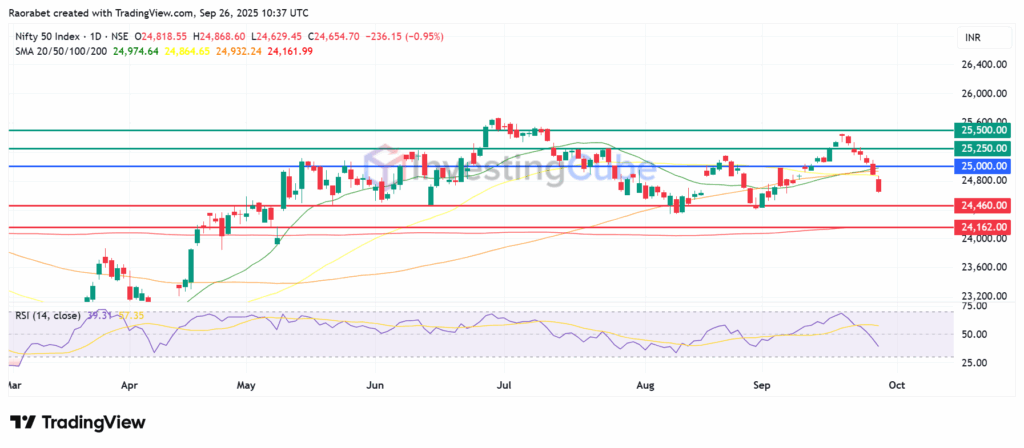- The Nifty 50 Index is has declined below the psychological 25,000 points level. We discuss the cause and the pathway to recovery.
The Nifty 50 Index (INDEXNSE: NIFTY_50), India’s benchmark stock market index, has been performing poorly in recent days, registering losses for six straight trading sessions. This fall, which has caused the index to drop below key psychological levels, has made investors more cautious.
The index closed at about 24,890 on Thursday, down from highs of about 25,450 mid this month. This is the longest losing streak since July. Several interconnected factors are fueling this decline, and we discuss them below and assess the pathway to a potential recovery.
Why the Nifty 50 Index is Declining
First, investors are still on edge because they don’t know what will happen with the larger US-India trade negotiations. They are concerned about more policy shocks that could hurt corporate earnings. Notably, there has been a steady exodus of foreign institutional investors (FIIs), with sales this week alone reaching about ₹9,000 crore (about $1.015 billion) due to concerns about high valuations and global uncertainty.
There has been a long period of net selling by foreign investors in the Indian market, with large capital leaving the country’s economy. Most of those leaving are doing so because they are afraid of the prevailing global risks. When there is rising uncertainty in the world, FIIs often pull money out of developing countries like India and put it into safer assets, usually US-denominated ones.
There have also been problems with trade and geopolitics. Recent changes in US-India trade relations have caused a lot of tension in certain sectors. The Indian Information Technology (IT) sector, which relies significantly on H-1B visas to do business in the US, has been adversely affected by the news of a multifold rise in H-1B visa fees.
Also, the current decline is partly due to FIIs and domestic investors booking profits following a period of high performance. The India VIX has jumped 9% over five sessions, showing that investors are less secure than usual. Reasons given by analysts include corrections caused by overbought conditions earlier this year, when the Nifty was trading at premium prices.
Is a Near-Term Recovery Possible?
The short-term outlook is still cautious, but a few important things could contribute to a relief rally or a structural rebound. The index is getting close to important long-term support levels, and the Relative Strength Index (RSI) signals that the market is oversold. This typically means that a temporary bounce is coming.
If the price drops below 24,460, it could lead to more selling, which could bring the 200-day simple moving average down to about 24,162. If the index stays above 24,460 and breaks through resistance at 25,000–25,250, it could bounce back to 25,500 in the near term, especially if global signals stabilize.

The Nifty 50 Index on a Daily Chart. Source: TradingView
In Summary
In essence, the outlook is still cautious because bearish momentum is still in charge. Even though FII selling and U.S. policy uncertainties are the main narratives, a short-term comeback depends on technical holds and positive news. Investors should keep a careful eye on key levels and pick conservative stocks when the market is volatile.
The main factors at play are persistent Foreign Institutional Investor (FII) outflows and heightened trade/visa uncertainties impacting especially the IT sectors.
A recovery of the Index requires positive outcome of US-India trade negotiationsand strong, performance in the upcoming corporate earnings season.
The outlook is cautious. A recovery hinges on holding 24,900 support and positive domestic policies and global geopolitical and economic stability.


